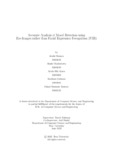| dc.contributor.advisor | Rahman, Tanvir | |
| dc.contributor.advisor | Shakil, Arif | |
| dc.contributor.author | Hossain, Arafat | |
| dc.contributor.author | Chakraborty, Akash | |
| dc.contributor.author | Syara, Syeda Rifa | |
| dc.contributor.author | Rahman, Saadman | |
| dc.contributor.author | Tanmoy, Fahad Muntasir | |
| dc.date.accessioned | 2023-10-12T10:43:55Z | |
| dc.date.available | 2023-10-12T10:43:55Z | |
| dc.date.copyright | ©2022 | |
| dc.date.issued | 2022-06-05 | |
| dc.identifier.other | ID 18101023 | |
| dc.identifier.other | ID 18101019 | |
| dc.identifier.other | ID 18101162 | |
| dc.identifier.other | ID 18101605 | |
| dc.identifier.other | ID 18101325 | |
| dc.identifier.uri | http://hdl.handle.net/10361/21792 | |
| dc.description | This thesis is submitted in partial fulfillment of the requirements for the degree of Bachelor of Science in Computer Science and Engineering, 2022. | en_US |
| dc.description | Cataloged from PDF version of thesis. | |
| dc.description | Includes bibliographical references (pages 30-31). | |
| dc.description.abstract | There are several works on mood detection by machine learning from physical and neuro- physical data of people, along with works on emotion recognition using eye-tracking. We want to show that a person’s mood can be detected using their eye images only. The mood is reflected through one’s eyes. The goal is to establish a connection between an individual’s mood and one’s eye images. The machine learning algorithm that we are going to use is Convolutional Neural Network (CNN) because it does not require external feature extraction. They system learns to extract the features by itself. In this paper, we developed two CNN models and used FER- 2013 as our dataset from which we used only the eye images for each of the six emotions: happy, fear, sad, angry, neutral and surprise to create our own dataset. We trained and tested our models with both FER-2013 dataset as well as our own dataset and compared the results. For FER-2013 dataset, our final accuracy score for model 1 was 83.78% with a validation accuracy score of 65.35%. It was seen that our model 1 showed the final accuracy score of 69.19% with a validation accuracy of 72.08% whereas for model 2, the final accuracy was 66.55% with a validation accuracy of 72.36% when trained and tested with our own dataset. The low accuracy for our dataset is due to the limitations that we faced for insufficient training and testing images. The accuracy can be improved with a better dataset for training our models. | en_US |
| dc.description.statementofresponsibility | Arafat Hossain | |
| dc.description.statementofresponsibility | Akash Chakraborty | |
| dc.description.statementofresponsibility | Syeda Rifa Syara | |
| dc.description.statementofresponsibility | Saadman Rahman | |
| dc.description.statementofresponsibility | Fahad Muntasir Tanmoy | |
| dc.format.extent | 37 pages | |
| dc.language.iso | en | en_US |
| dc.publisher | Brac University | en_US |
| dc.rights | Brac University theses are protected by copyright. They may be viewed from this source for any purpose, but reproduction or distribution in any format is prohibited without written permission. | |
| dc.subject | Machine learning | en_US |
| dc.subject | CNN | en_US |
| dc.subject | Convolutional neural network | en_US |
| dc.subject | Eye tracking | en_US |
| dc.subject | FER | |
| dc.subject | Facial expression recognition | |
| dc.subject.lcsh | Human-computer interaction | |
| dc.subject.lcsh | Pattern recognition systems | |
| dc.title | Accurate analysis of mood detection using eye-images rather than facial expression recognition (FER) | en_US |
| dc.type | Thesis | en_US |
| dc.contributor.department | Department of Computer Science and Engineering, Brac University | |
| dc.description.degree | B.Sc. in Computer Science and Engineering | |

